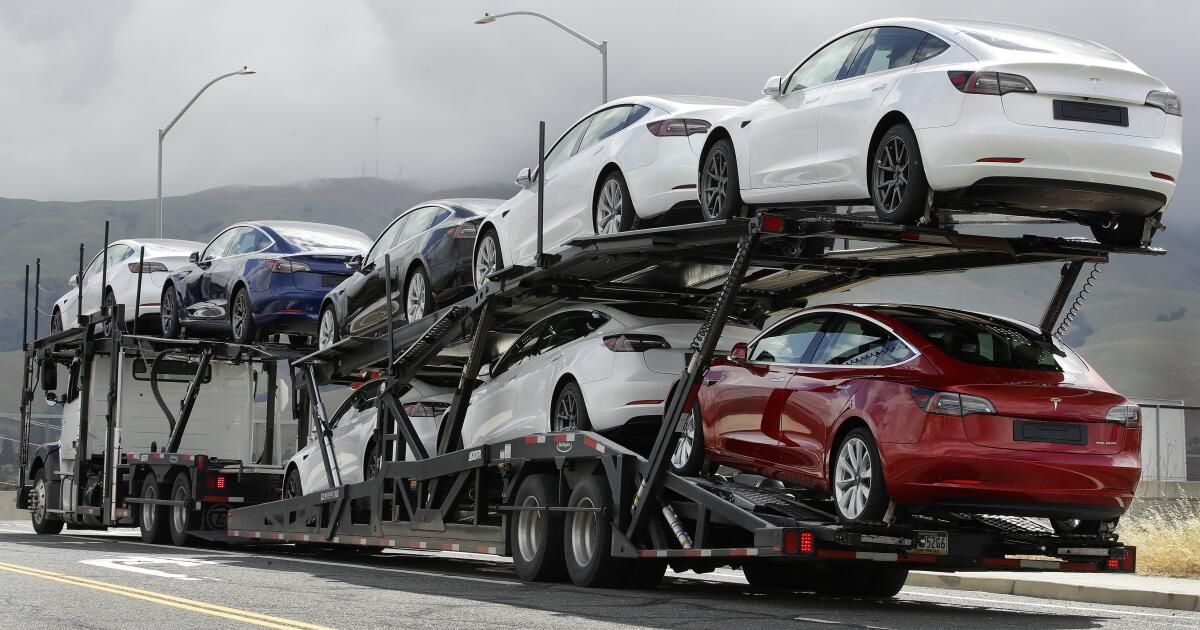Ira Newlander of West Los Angeles has been thinking about replacing his 1997 Ford Explorer with a hybrid or all-electric car, but there's something bothering him on the market these days.
Like many Californians who have been assaulted by a flat tire off the beaten path, Newlander wants his new car to come with a spare. But the vast majority of hybrid and battery-powered cars don't have it.
Newlander expressed his frustration to Honda in a recent email, urging the company to put a full-size replacement in its electrified cars.
“I have conducted an informal survey of family and friends,” wrote Newlander, a retired court reporter. “The consensus is that saving £40 or £50 for a full replacement on a vehicle that weighs between 1.5 and 2 tonnes is foolish. It's irrelevant compared to the risk of being stuck in the middle of nowhere without a real spare. It turns a discussion about spare parts into a discussion of desperation.”
In response, Honda customer service told Newlander that “the reason the spare tire is not included in our new electric vehicles is actually a safety concern.”
“The problem is that if the vehicle is in an accident, the spare tire can damage the electric battery, which could lead to battery failure,” the company email explains.
Car design experts said the explanation was plausible but far-fetched. There is a simpler explanation for the abandonment of spare tires: They are too big and heavy, and people no longer need them.
Here is a summary of the problems preventing spare parts from being available in the new generation of battery-powered cars.
The disappearing spare part phenomenon
Automakers have been removing full-size parts from their smaller sedans and SUVs for some time. In 2018, Consumer Reports said, 60% of the vehicles it had tested over the previous five years came with small-size temporary tires (“doughnuts”), and only 10% came with full-size replacements.
However, more and more cars are skipping the donut in favor of run-flat tires (tyres that you can continue driving on after a puncture), puncture kits, roadside assistance or… nothing.
The best-selling models of electric sedans and SUVs (Teslas, Chevy Bolt, Volkswagen ID.4, Ford Mustang Mach-E, Hyundai Ioniq 5, BMW i4 and Mercedes EQS) do not have spare parts of any kind. even if they have a higher price. The same goes for hybrids; The Toyota Prius, for example, has not included a spare part since 2016.
That's not because people magically stopped getting flat tires. American drivers suffer 94 million flat tires a year, according to LookupAPlate.com, a site that compiles reports on bad drivers.
The competition for space
Although spare tires can still be found on some “adventurous” large trucks and SUVs, one problem for automakers is the increasing size of wheels on new cars, said Geoff Wardle, executive director of transportation systems and design at ArtCenter College of Design. “Try to find adequate clearance on a Range Rover or Jeep Wagoneer for an 8-by-22-inch wheel shod with a cross-country tire,” he said.
That's why many manufacturers have turned to alternatives, such as inflatable replacements that take up about a third of the volume of a full-size tire. Or they can equip their cars with self-sealing or run-flat tires, which Wardle says are “good if it's just a nail puncture, but useless if you hit a pothole and tear the rim and sidewall.”
Finding room for a spare is particularly difficult for a car powered by anything other than gasoline, designers say. “To extend the range of electric vehicles it is necessary for batteries, electrical system control units or hydrogen tanks to invade the traditional places where spare tires are located: under the trunk floor,” Wardle said.
The space crunch is worse for hybrids, which require space for both a battery system and an internal combustion engine, said Scott Grasman, dean of the College of Engineering at Kettering University in Flint, Michigan.
The need to lose weight
A full-size replacement adds 30 to 50 pounds to a car, Wardle said; a typical donut adds about 25 pounds. As automakers try to meet increasingly stringent emissions and fuel efficiency requirements, Wardle said 30 to 50 pounds of spare tire “is significant.”
“You might think that's trivial” compared to the weight of a car, Grasman said. But “if you're trying to get all the range you can, having a 25-pound tire means extra weight that you just have to carry with you,” he said.
Gil Tal, director of the Electric Vehicle Research Center at UC Davis, said removing the spare probably increases an electric car's range by a “point something.” “If it's a 400 mile car, it's [an extra] a mile or two,” he said. But after a manufacturer takes all the simple steps to increase range, he said, it's left to go as many miles as it can.
The drive to reduce costs
Equipping a car with a spare tire increases the cost of its construction. Grasman estimated that adding a full-size replacement costs the manufacturer between $100 and $300, depending on the vehicle.
And tires for an electric vehicle can be more expensive than those for a gasoline vehicle of the same size. This is because electric vehicles tend to be heavier than their gasoline counterparts, so they require sturdier tires. And with comparatively quiet engines, they need tires that don't generate as much road noise.
Do spare parts pose a safety threat to electric vehicles?
Honda did not respond to a request for more details about the email sent to Newlander, so it's difficult to know what it thought the safety issue might be.
Tal, of UC Davis, was skeptical that manufacturers were leaving out parts for their hybrids and electric vehicles for that reason. “As far as I know,” he said, “it has nothing to do with security.”
Wardle said that with a heavy spare wheel positioned close to an elaborate, heavy battery assembly at the bottom of the trunk, “there is a danger that in a severe frontal impact – a head-on crash – that spare wheel could come off its medium”. is fired and becomes a projectile that passes through the battery unit. Thus, in addition to the risk of injury to passengers and bystanders due to the actual forces of the collision, there is the possibility of short circuits and explosive overheating of the high-voltage battery unit.”
Grasman acknowledged that, although unlikely, it is possible that a replacement could damage a battery in an accident. But he added: “The design of the vehicle could be changed to make sure that doesn't happen.”
He also questioned why Honda would want to suggest that a replacement could damage the battery in a collision.
“What about the headrest, what about all the cargo I keep in my trunk?” -Grasman asked. “I think they're opening up a little bit.”
Do you really need a replacement?
Tal said the tires are much better and more durable than before. And because federal regulations require new cars to have tire pressure gauges, he said, drivers are alerted as soon as their tires need air.
“In most cases, flat tires… are the result of prolonged driving at low pressure,” he said. “And if you drive a modern car, it will tell you [that] you have low pressure long before you suffer catastrophic failure” of a floor.
Many cars without spare parts come with kits to patch and re-inflate a tire that is low on air. But even when a tire goes flat, Tal said, “the most common behavior today is to call AAA and sit in your car and play on your phone.”
That's the behavioral side of the equation, Grasman said. “People don't know how to change a spare tire, so they won't do it anyway,” he said.
For these drivers, automakers can safely assume that a can of Fix-a-Flat will be more useful than a spare part, a jack, and a tire iron. Alternatively, manufacturers can offer roadside assistance for free (as Tesla does) or for a fee (through services like OnStar, owned by General Motors).
Newlander said it's selfish for automakers to argue that people don't need a replacement part. “For driving around town or short distances or during the day, it's one thing” to go without a backup tire. “But for an overnight return from, say, San Diego, or Mammoth, I don't think so.”
He has some experience on that front. “We had a flat tire in the mountains, I don't know, 10 years ago,” she said. “It was good because we had a spare tire.”
About the Times public service journalism team
This article is from The Times' public services journalism team. Our mission is to be essential to the lives of Southern Californians by publishing information that solves problems, answers questions, and helps with decision-making. We serve audiences in and around Los Angeles, including current Times subscribers and diverse communities whose needs have historically not been met by our coverage.
How can we be helpful to you and your community? Email utility (at) latimes.com or one of our journalists: Jon Healey, Ada Tseng, Jessica Roy and Karen García.









